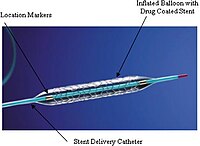
Photo from wikipedia
BACKGROUND Coronary artery spasm (CAS) and significant coronary stenosis are known to be major causes of myocardial ischemia. However, their association and the impact of insignificant coronary stenosis (ICS) on… Click to show full abstract
BACKGROUND Coronary artery spasm (CAS) and significant coronary stenosis are known to be major causes of myocardial ischemia. However, their association and the impact of insignificant coronary stenosis (ICS) on long-term clinical outcomes of CAS patients are largely unknown. METHODS A total of 2797 patients without significant coronary artery disease (CAD) who underwent the acetylcholine (ACH) provocation test between November 2004 and October 2010 were enrolled. Significant CAS was defined as having ≥70% of temporary narrowing by ACH test and ICS as having <70% of fixed stenosis on angiography. Patients were divided into two groups: ICS group (n=764) and non-ICS group (n=845). To adjust potential confounders, a propensity score matching (PSM) analysis was performed using the logistic regression model. Primary endpoint was the composite of total death, myocardial infraction (MI), de novo percutaneous coronary intervention (PCI), and cerebrovascular accidents (CVA). Secondary endpoint was the incidence of recurrent angina requiring repeat coronary angiography (CAG) at 3years. RESULTS After PSM analysis, two well-balanced groups (548 pairs, total=1096) were generated. The baseline clinical characteristics were similar between the two groups. During the ACH test, compared with the non-ICS group, the ICS group had smaller spastic narrowing diameter (0.69±0.35 vs. 0.73±0.37, P=0.039) and incidence of ST-segment depression (4.0% vs. 0.9%, P=0.001). The incidence of primary and secondary endpoints was similar between the two groups up to 3years. CONCLUSIONS Although, the ICS group was expected to have more adverse long-term clinical outcomes, it was not associated with the increased incidence of major adverse clinical outcomes compared with the non-ICS group up to 3years. Longer term follow-up studies are needed.
Journal Title: International journal of cardiology
Year Published: 2017
Link to full text (if available)
Share on Social Media: Sign Up to like & get
recommendations!